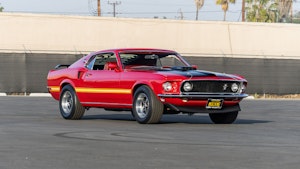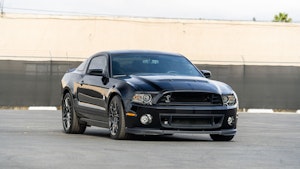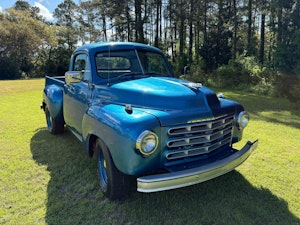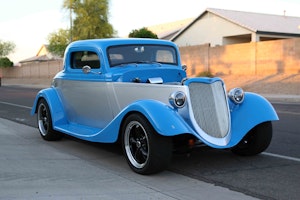Media | Articles
Classic Car Tires: Everything You Need to Know
There’s a certain “chef’s kiss” feeling when the details on a car are just right. Whether you’ve spotted them at a show, a local cruise-in, or an online listing, period-style tires on a vintage car look great—and they can make a big difference in how an old vehicle drives. Modern tires made specifically for classic cars are even better than the originals.
The terms “modern” and “classic car” may seem incongruous when describing this type of tire, but in reality, they’re a perfect descriptor. A modern classic car tire looks like what might have been mounted to a car’s wheels from the factory when it was new, but they’re manufactured with up-to-date rubber compounds and construction designed to last a long time, hold up to major temperature variations, and provide good traction on a variety of surfaces. These are not your typical reproduction parts.
Here’s what you need to know about this special kind of tire.
Classic Car Tire Basics: What Makes Them Different?

The wheels on many postwar cars can handle standard passenger car tires, even if their sizing isn’t quite the same as what the manufacturer originally specified. For instance, the original tire size on a 1968 BMW 2002 is listed as “165 SR 13” in the owner’s manual; if you roll down to your local big-box tire shop with those numbers, they’ll probably steer you toward the present-day equivalent, approximately a 185/70R-13 tire. Major retailer Tire Rack offers a few tires in that size, ranging from about $72 to upward of $330 per corner. That’s a massive price span, and it might seem tempting to buy four of the cheapest for less than one of the most expensive.
The compound and tread on the cheapest tire in this situation is meant for a modern compact car, like a Toyota Corolla, while the big-buck ones have been designed for a vintage car. They’re both round and black, but that’s about where the similarities end.


Compared to today’s tires, classic car tires have a uniquely shaped carcass—the industry term for the tire’s profile—that results in a smaller contact patch with the pavement below. A thinner patch of rubber on the ground isn’t a boon for traction, but it does make the car easier to turn if the steering system is unassisted. The rounded carcass of a tire meant for a classic car also rolls over differently in hard cornering, which results in handling more akin to what the automaker originally intended.
These tires are also made from modern compounds that are more durable and heat-resistant than what tire manufacturers were able to use in period. They’ll last far longer than the originals, and they’ll provide better traction. Manufacturers assemble them to quality standards simply unachievable back when your car was brand new.
Advancements in synthetic polymers, silica, and carbon black over the last several decades have helped make modern tires grippier, less prone to punctures, and more fuel-efficient than the rubber your classic first wore when it left the factory. Conversely, tire manufacturers face more manufacturing and material-sourcing restrictions today than they did decades ago. Producers have begun to turn to more sustainable ways of producing rubber, an initiative addressing major concerns about the amount of rubber particles in the atmosphere that can be traced to tire dust.
Just what goes into a tire’s construction is proprietary—a closely guarded secret recipe that no tire manufacturer will fully disclose.
“Using a high-quality, full-silica tread compound, we ensure an ideal blend of heritage styling with modern safety and handling performance,” says Patrick Meeley, a representative for Dutch manufacturer Vredestein, which has a wide lineup of classic car tires. “Every aspect of the tread and compound works together seamlessly to achieve this balance.”
Classic car tires also have a tread pattern that looks period-correct. Put tires intended for a Corolla on the BMW 2002 example above and they just won’t look right.
Marketplace
Buy and sell classics with confidence
Bias-Ply vs. Bias-Ply Look vs. Radial Tires
Beginning in the late 1960s and continuing into the early 1980s, automakers phased out bias-ply tires in favor of long-lasting radial tires. If you have a classic car that was built before the phase-out, you may want to weigh the advantages of each construction type.

Bias-ply tires have lots of rubber and soft sidewalls that result in a pillowy ride. However, they give up quickly in hard cornering, tend to make the steering wander at speed, and don’t last very long. Unless you’re willing to live with these major compromises in pursuit of a wholly authentic vintage driving experience, or the only movement your car does is from the trailer to the concours field, you should probably stick with radial tires.
“[Bias-ply] tires replicate the look, feel, and driving characteristics of the original period-correct tires, making them ideal for car shows, Concours events, and hot rods where maintaining historical accuracy is essential,” Coker Tire representative Matthew Millsaps explains.
Then there are bias-ply look tires—modern-construction tires designed for cars from the mid-1970s or earlier that, despite authentic appearances, are radials. They feature an “R” in the tire size descriptor, indicating as such.
“They’re simply the best of both worlds,” Millsaps said.
Shopping For Classic Car Tires

Enthusiasts have a lot more tire choices today for a period-style tire than even a decade ago. A number of tire manufacturers offer classic lines, including Dunlop, Michelin, Pirelli, and Vredestein. Others, like BFGoodrich and Firestone, have licensed their designs to Coker Tire.
Not all classic tires are created equal. Michelin’s Pilot Exalto PE2 tire, for instance, was developed in the early 2000s when the manufacturer watched wheel sizes grow and discovered that owners of 1980s and 1990s “modern classics” with tires sized between 13 and 16 inches had few options. The Exalto range doesn’t emulate a classic tread design, though the small sizes make it an appealing choice for sports cars.
Some choices come down to personal—or period—preferences, like white sidewall lettering (commonly called OWL, or outline white lettering), whitewalls, or Vogues with gold stripes. There’s nothing like Firestone Wide O Oval lettering for a 1977 Pontiac Firebird Trans Am, after all. Such decisions may be very easy to make.

A handful of automakers—Porsche and Mazda, in particular—make it easy. They have partnered with tire manufacturers to develop rubber specifically intended for their vehicles. Tires vetted by Porsche have an “N” marking on them, which major tire retailers will also typically call out. The automaker’s classic division, Porsche Classic, even maintains a tire approval list, though you may want to contact a dealer for the latest iteration.


Ultimately, you should talk to an expert before ordering tires. Coker, Tire Rack, and other specialty retailers have car enthusiasts on staff who can help steer you in the right direction.
“We like to talk cars,” Millsaps says. “And tires.”
Why You Might Not Want Classic Car Tires

Beyond price considerations, there are a few reasons why tires designed for a modern car might be a better fit.
Suppose you plan to use your car for track days. In that case, you may benefit from a dedicated performance tire with a wide contact patch and a rubber compound specifically meant for the heat generated by repeated, grueling use. Of course, that’s all thrown out the window if your car competes in vintage road racing, where period-style tires are a must-have.

Beware, however, that a modern-style tire will wear out your car’s suspension components and wheels in ways you might not expect. That wide contact patch and stiff sidewall that contribute to so much grip will stress the vehicle’s components beyond what its designers intended. You may wind up replacing suspension parts and wheels earlier than expected.
“This can make the ride harsher and reduce the ‘vintage’ driving experience, such as the softer, more forgiving ride and looser handling dynamics some classic cars are known for,” noted Millsaps.
Speaking of wheels, your resto-modded muscle car that rides on 18-inchers will need modern-design tires. Then again, if you’re putting big wheels on your old car, you’re probably not prioritizing ride quality, anyway.
It’s all a matter of preference, but there are more tire choices than ever to create the driving experience, look, and authenticity enthusiasts want. Happy driving!


























I’ve always considered tires to be one of the most important aspects of a safe ride.
All comments posted are useful and correct for the purpose of the individual owner, be it an original collectible or Pro-mod.
However, never forget what your particular choice is and Do Not push beyond the tires capabilities. Guard rails, trees and all other objects on your pleasure cruise are unforgiving. Don’t learn the hard way.
Believe me, I learned the hard way. And it’s expensive, ‘nuff said.
I think you left out a major reason one might not want to use new “classic” tires. These are almost all summer tires with manufacturer recommendations to not drive on them (certainly not to install them) in temps below 40-45 degrees. I replaced 10-year old Michelin all-season tires on my Alfa Spider with new Pirelli Cinturatos, which I learned are summer tires not recommended for a drive on a cold day. Makes the occasional winter drive much less frequent, waiting for a warm enough day.
Thankfully my classic uses modern performance tires so I have few issues besides selection at stock sizes.
Quite often, when l have bought a “new” classic car from the ’50s or ’60s, it first arrives home with much too wide radials, and often, inexplicable, installed on 5 inch stock narrow rims! lt ‘s really difficult to steer the car unless it’s moving (with manual steering), the car rides like a lumber wagon, and all the rattles and squeaks (especially in true hardtops) make you wonder if you should just “flip” it, not love it.
My cars come from a non-radial era and the solution to the above problems was bias-ply tires. The ride was soooo much better that 1/2 the rattles just disappeared – and suddenly my cars had what seemed to be power steering (delightfully easy turning). IF the front suspension and steering joints and all bushings are in decent shape, the car will behave just fine with bias-plies.
Several friends and l have Studebakers that have used several sets of Coker-sourced BF Goodrich 670-15 wide whites for many years and we’ve had no problems (other than becoming expensive lately).
As touched on also by one earlier comment, Our stock Stude rims were not made for radial tires and the tech advisers in the Studebaker Drivers Club say that prolonged use of radials on rims not made for them risks catastrophic failure through cracking – and show photo proof! Thankfully, later-era 6 inch steel rims from Chrysler and Ford can be bolted on our cars – if you must have radials.
My cars only get mild use and the flat-head 6 cylinders no longer venture onto major multi-lane hiways since the “double nickel” speed limit was revoked!
I am a Mopar guy and I really love the look of the white lettering on the old Good Year Polyglass GT tires. Coker has red stripe tires in a wide radial. I wish they could do the same with those Polyglass tires and come up with some modern 15” radials.
Oh and the whole thing about tires aging out is a myth propagated by tire stores to sell you more product. If they are stored out of the sunlight and haven’t grown hard or weather checked, and all you’re doing is cruise nights and local shows, you’re fine.
I’ll kindly ask that you cite a source for this “if it looks fine it is fine” on tires because like any rational person, I am more inclined to trust experts than one dude in the comments section. Anecdotal stories need not apply. Show me where any expert on tires has said a statement that agrees with yours.
I wasn’t going to comment on this but I agree with Buzz so there are at least two of us. I’ve run pre-date-coded tires, routinely run 10+ year old tires on my daily and have never had a problem. I don’t think I’m that lucky. If they look and feel good I run them.
Somewhat recently Jay Leno was out for a ride in one of his collection cars and had a out-of-date-but-look-OK tire fail. It made him realize that he had something like 800 tires to replace!
I’ve been restoring vintage cars for years. I thought I knew something about tires. I didn’t, thanks for a great article. ………Jim.
My 1968 Firebird handled better in snow than my 2016 Audi A4. With “skinny” snow tires in the rear the car handled great, while the Audi with 4 wheel drive and “fat” tires floats over the snow. I feel technology has gone backwards.
You may be comparing apples and oranges. You don’t say if you’ve tried a modern snow tire on your Audi. Only then will you know how much difference their truly is.
When I run winter (snow) tires on my late model vehicles, I like to get another set of wheels, 1″ or 2″ smaller diameter and then Match the Tire Rotations per mile. It’s available on Tire Rack. I’ve had very good results with this, including on a 2001 Mustang GT.
After burning through many set of Dunlap Vintage Sport tires (about 1500 miles) on my 1953 Kellison J4 roadster, and dealing with considerable “bump steer” at higher speeds, I discovered the Michelin Pilote X, a radial tire with vintage looking tall sidewalls. I have now over 800 miles on these radial tires and the car has never handled better.
Back in the ’70s, the neighbor’s teenage son bought a beautifully maintained Cutlass from a professional mechanic. Driving along in a leisurely manner, an aging front tire blew, causing damage to the wheel well.
Probably would’ve been nice if for the Firestone Wide Oval tires, you mentioned a 77′ Pontiac Trans Am, but showed a 71′ or 72′ Trans Am. Should probably get your facts straight before showing and mentioning a car for an article
I’ve seen ads (and the above photos) for Pirelli CN36 radials, original fitment on early 70s Porsche 911s, but I don’t find them in the original size: 175/70R-15. Vredestein Sprint Classic does offer that size at a good price, but I am nostalgic for the Pirellis.
“The compound and tread on the cheapest tire in this situation is meant for a modern compact car, like a Toyota Corolla, while the big-buck ones have been designed for a vintage car.”
You forgot to add:
“while the big-buck ones have been designed for for a vintage car and an owner with big-bucks!”
“white sidewall lettering (commonly called OWL, or outline white lettering)”
Well, there are outlined white letters and solid white letters…
Nice article, but I’ll issue my standard complaint: where are the decent modern PERFORMANCE tires in vintage sizes that don’t cost a mint? Finding 26″-ish diameter by wide-ish 15″ or 24″-ish diameter by wide-ish 16″ performance tires with modern compounds for my restomodded ’70 Mustang or ’89 XR4TI has been disappointing. Most offerings in the right sizes have lower speed ratings, lower traction ratings, and generally, a rather mediocre reputation, especially in wet weather. But maybe that’s the issue: there are fewer and fewer people actually driving these cars for more than casual “Sunday drives” and car shows and cruise-ins. So alas, we’re relegated to upsizing our wheels to be able to use better modern tire designs and compositions, which is a bummer. Because I’d sure love to be able to keep a more vintage look while enjoying driving the cars.